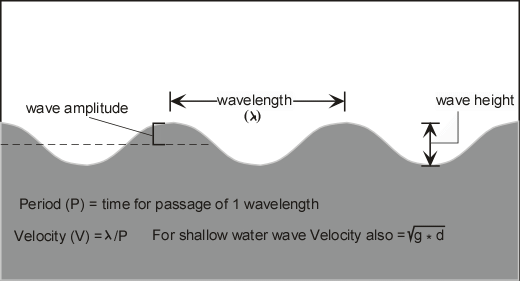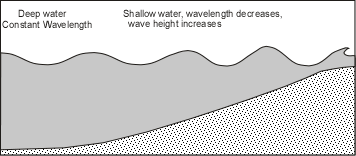What is a Tsunami
A tsunami is a very long-wavelength wave of water that is generated by sudden displacement of the seafloor or disruption of any body of standing water. Tsunami are sometimes called "seismic sea waves", although they can be generated by mechanisms other than earthquakes. Tsunami have also been called "tidal waves", but this term should not be used because they are not in any way related to the tides of the Earth. Because tsunami occur suddenly, often without warning, they are extremely dangerous to coastal communities.
Physical Characteristics of Tsunami
All types of waves, including tsunami, have a wavelength, a wave height, an amplitude, a frequency or period, and a velocity.
|

V = l/P |
| Tsunami are characterized as shallow-water waves. These are different from the waves most of us have observed on a the beach, which are caused by the wind blowing across the ocean's surface. Wind-generated waves usually have period (time between two successive waves) of five to twenty seconds and a wavelength of 100 to 200 meters. A tsunami can have a period in the range of ten minutes to two hours and wavelengths greater than 500 km. A wave is characterized as a shallow-water wave when the ratio of the water depth and wavelength is very small. The velocity of a shallow-water wave is also equal to the square root of the product of the acceleration of gravity, g, (10m/sec2) and the depth of the water, d. As a tsunami leaves the deep water of the open sea and arrives at the shallow waters near the coast, it undergoes a transformation. Since the velocity of the tsunami is also related to the water depth, as the depth of the water decreases, the velocity of the tsunami decreases. The change of total energy of the tsunami, however, remains constant. |
 |
| Furthermore, the period of the wave remains the same, and thus more water is forced between the wave crests causing the height of the wave to increase. Because of this "shoaling" effect, a tsunami that was imperceptible in deep water may grow to have wave heights of several meters or more. If the trough of the tsunami wave reaches the coast first, this causes a phenomenon called drawdown, where it appears that sea level has dropped considerably. Drawdown is followed immediately by the crest of the wave which can catch people observing the drawdown off guard. When the crest of the wave hits, sea level rises (called run-up). Run-up is usually expressed in meters above normal high tide. Run-ups from the same tsunami can be variable because of the influence of the shapes of coastlines. One coastal area may see no damaging wave activity while in another area destructive waves can be large and violent. The flooding of an area can extend inland by 300 m or more, covering large areas of land with water and debris. Flooding tsunami waves tend to carry loose objects and people out to sea when they retreat. Tsunami may reach a maximum vertical height onshore above sea level, called a run-up height, of 30 meters. A notable exception is the landslide generated tsunami in Lituya Bay, Alaska in 1958 which produced a 60 meter high wave. |
| Because the wavelengths and velocities of tsunami are so large, the period of such waves is also large, and larger than normal ocean waves. Thus it may take several hours for successive crests to reach the shore. (For a tsunami with a wavelength of 200 km traveling at 750 km/hr, the wave period is about 16 minutes). Thus people are not safe after the passage of the first large wave, but must wait several hours for all waves to pass. The first wave may not be the largest in the series of waves. For example, in several different recent tsunami the first, third, and fifth waves were the largest. How Tsunami are Generated There is an average of two destructive tsunami per year in the Pacific basin. Pacific wide tsunami are a rare phenomenon, occurring every 10 - 12 years on the average. Most of these tsunami are generated by earthquakes that cause displacement of the seafloor, but, as we shall see, tsunami can be generated by volcanic eruptions, landslides, underwater explosions, and meteorite impacts. Earthquakes Earthquakes cause tsunami by causing a disturbance of the seafloor. Thus, earthquakes that occur along coastlines or anywhere beneath the oceans can generate tsunami. The size of the tsunami is usually related to the size of the earthquake, with larger tsunami generated by larger earthquakes. But the sense of displacement is also important. Tsunami are generally only formed when an earthquake causes vertical displacement of the seafloor. The 1906 earthquake near San Francisco California had a Richter Magnitude of about 7.1, yet no tsunami was generated because the motion on the fault was strike-slip motion with no vertical displacement. Thus, tsunami only occur if the fault generating the earthquake has normal or reverse displacement. Because of this, most tsunami are generated by earthquakes that occur along the subduction boundaries of plates, along the oceanic trenches. Since the Pacific Ocean is surrounded by plate boundaries of this type, tsunami are frequently generated by earthquakes around the margins of the Pacific Ocean. Examples of Tsunami generated by Earthquakes Although the December 2004 Indian Ocean tsunami is by far the best well known and most deadly (and will be featured in a video in class), we here discuss other disastrous tsunami generated by earthquakes. |
Volcanic Eruptions
Volcanoes that occur along coastal zones, like in Japan and island arcs throughout the world, can cause several effects that might generate a tsunami. Explosive eruptions can rapidly emplace pyroclastic flows into the water, landslides and debris avalanches produced by eruptions can rapidly move into water, and collapse of volcanoes to form calderas can suddenly displace the water.
The eruption of Krakatau in the Straights of Sunda, between Java and Sumatra, in 1883 generated at least three tsunami that killed 36,417 people. It is still uncertain exactly what caused the tsunami, but it is known that several events that occurred during the eruption could have caused such tsunami.
One of the tsunami had a run-up of about 40 m above normal sea level. A large block of coral weighing about 600 tons was ripped off the seafloor and deposited 100 m inland. One ship was carried 2.5 km inland and was left 24 meters above sea level, with all of its crew swept into the ocean. |
Landslides Landslides moving into oceans, bays, or lakes can also generate tsunami. Most such landslides are generated by earthquakes or volcanic eruptions. As previously mentioned, a large landslide or debris avalanche fell into Lituya Bay, Alaska in 1958 causing a wave with a run-up of about 60 m as measured by a zone completely stripped of vegetation. Underwater Explosions Nuclear testing by the United States in the Marshall Islands in the 1940s and 1950s generated tsunami. Meteorite Impacts While no historic examples of meteorite impacts are known to have produced a tsunami, the apparent impact of a meteorite at the end of the Cretaceous Period, about 65 million years ago near the tip of what is now the Yucatan Peninsula of Mexico, produced tsunami that left deposits all along the Gulf coast of Mexico and the United States. Tsunami Safety Rules In case you are ever in an area where there is a threat of tsunami, I have downloaded the following tsunami safety rules from the West Coast & Alaska Tsunami Warning Center Home Page: http://wcatwc.arh.noaa.gov/safety.htm
|
No comments:
Post a Comment